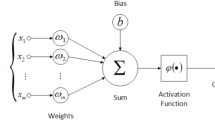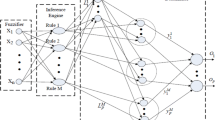Abstract
This paper represents the design of a class-F power amplifier (PA), its artificial neural network (ANN) model and a PA linearization method. The designed PA operates at 1.8 GHz with gain of 12 dB and 1dB output compression point (P1dB) of 36 dBm. The proposed ANN model is used to predict the output power of designed class-F PA as a function of input and DC power. This model utilizes the designed class-F PA as a block, which could be used in a desired linearization circuit. In addition, the power added efficiency (PAE) and the other specifications of a PA, related to power can be predicted using the proposed model. A simple feedforward technique is used to improve the linearity of designed PA. For verification, this linearization method is compared with presented neural network model simulations. The results show the improvement of P1dB from 36 to 41 dBm, which is predicted using the proposed model. Also, the PAE of the final linearized circuit PA is predicted.









Similar content being viewed by others
References
Grebennekov, A.: RF and Microwave Power Amplifier Design. McGraw Hill, New York (2004)
Raab, F.H., Asbeck, P., Cripps, S., Kenington, P., Popovic, Z., Pothecary, N., Sevic, J., Sokal, N.: Power amplifiers and transmitters for RF and microwave. IEEE Trans. Microwave Theory Tech. 50(3), 814–826 (2002)
Gao, S.: High efficiency class-F RF/microwave power amplifiers. IEEE Microwav. Mag. 7(1), 40–48 (2006)
Zhu, A., Wren, M., Brazil, T.J.: An Efficient Volterra-Based Behavioral Model for Wideband RF Power Amplifiers. IEEE MTT-S International Microwave Symposium Digest, vol. 2. (2003)
Ding, L., et al.: A robust digital baseband predistorter constructed using memory polynomials. IEEE Trans. Commun. 52(1), 159–165 (2004)
Liu, W.: MOSFET Models for SPICE Simulation Including BSIM3v3 and BSIM4. Wiley, New York (2001)
Antonini, G., Orlandi, A.: Gradient evaluation for neural-networks-based electromagnetic optimization procedures. IEEE Trans. Microw. Theory Tech. 48(5), 874–876 (2000)
Devabhaktuni, V.K., Zhang, Q.J.: Neural network training-driven adaptive sampling algorithm for microwave modeling. Proceedings of 30th European Microwave Conference, pp. 222–225. Paris, France (2000)
Watson, P.M., Mah, M.Y., Liou, L.L.: Input variable space reduction using dimensional analysis for artificial neural network modeling. IEEE MTT-S Int Microwave Symposium Digest, pp. 269–272. Anaheim, CA (1999)
Mkadem, F., Boumaiza, S.: Physically inspired neural network model for RF power amplifier behavioral modeling and digital predistortion. IEEE Trans. Microw. Theory Tech. 59(4), 913–923 (2011)
Yuan, X.-H., Feng, Q.: Behavioral modeling of RF power amplifiers with memory effects using orthonormal hermite polynomial basis neural network. Prog. Electromagn. Res. C 34(1), 239–251 (2013)
Li, M., et al.: Complex-Chebyshev functional link neural network behavioral model for broadband wireless power amplifiers. IEEE Trans. Microw. Theory Tech. 60(6), 1979–1989 (2012)
Mkadem, F., et al.: Behavioral modeling and digital predistortion of power amplifiers with memory using two hidden layers artificial neural networks. IEEE MTT-S International Microwave Symposium Digest (MTT) (2010)
Bahoura, M., Park, C.-W.: FPGA-implementation of an adaptive neural network for RF power amplifier modeling. 9th IEEE International New Circuits and Systems Conference (NEWCAS). IEEE, (2011)
Lee, K.C., Gardner, P.: Neuro-fuzzy approach to adaptive digital predistortion. Electron. Lett. 40(3), 185–187 (2004)
Zaabab, A.H., Zhang, Q.J., Nakhla, M.: Analysis and optimization of microwave circuits & devices using neural network models. IEEE MTT-S International Microwave Symposium Digest, pp. 393–396. San Diego (1994)
Liu, T., Boumaiza, S., Ghannouchi, M.: Dynamic behavioral modeling of 3G power amplifiers using real-valued time-delay neural networks. IEEE Trans. Microw. Theory Tech. 52(3), 1025–1033 (2004)
Isaksson, M., Wisell, D., Ronnow, D.: Wide-band dynamic modeling of power amplifiers using radial basis function neural networks. IEEE Trans. Microw. Theory Tech. 53(11), 3422–3428 (2005)
Q.J. Zhang.: A neural network paradigm for microwave modeling, simulation and optimization. IEEE MTT-S International Microwave Symposium Workshop on Applications of ANN to Microwave Design, pp. 87–107. Denver, CO (1997)
Kothapalli, G.: Artificial neural networks as aids in circuit design. Microelectron. J. 26(6), 569–578 (1995)
Zaabab, A.H., Zhang, Q.J., Nakhla, M.: A neural network modeling approach to circuit optimization and statistical design. IEEE Trans. Microw. Theory Tech. 43(6), 1349–1358 (1995)
Goasguen, S., Hammadi, S.M., El- Ghazaly, S.M.: A global modeling approach using artificial neural network. IEEE MTT-S International Microwave Symposium Digest, pp. 153–156. Anaheim, CA (1999)
Fang, Y., Yagoub, M.C.E., Wang, F., Zhang, Q.J.: A new macromodeling approach for nonlinear microwave circuits based on recurrent neural networks. IEEE MTT-S International Microwave Symposium Digestive, pp. 883–886. Boston, MA (2000)
Kim, J., Konstantinou, K.: Digital predistortion of wideband signals based on power amplifier model with memory. Electron. Lett. 37(23), 1417–1418 (2001)
Jang, J.-S.: ANFIS: adaptive-network-based fuzzy inference system. IEEE Trans Syst. Man Cybern. 23(3), 665–685 (1993)
Zhai, J., Zhou, J., Zhang, L., Zhao, J., Hong, W.: The dynamic behavioral model of RF power amplifiers with the modified ANFIS. IEEE Trans. Microw. Theory Tech. 57(1), 27–35 (2009)
Chopra, P.K., Chandrasekhar, M.G.: ANN modeling for design of a matched low noise pHEMT amplifier for mobile application. J. Comput. Electron. 12(4), 743–751 (2013)
Caddemi, A., Donato, N., Xibilia, M.G.: Advanced simulation of semiconductor devices by artificial neural networks. J. Comput. Electron. 2(2–4), 301–307 (2003)
Karimi, G., Sedaghat, S.B., Banitalebi, R.: Sedighe Babaei Sedaghat, and Roza Banitalebi.: Designing and modeling of ultra low voltage and ultra low power LNA using ANN and ANFIS for bluetooth applications. Neurocomputing 120(1), 504–508 (2013)
Hayati, M., Lotfi, A.: Modeling of compact microstrip resonator using neural network: application to design of compact low-pass filter with sharp cut-off frequency. Microw. Opt. Technol. Lett. 53(6), 1323–1328 (2011)
Rahmati, M.M., Abdipour, A., Mohammadi, A., Moradi, G.: An analytic approach for CDMA output of feedforward power amplifier. Analog Integr. Circuits Signal Process. 66(3), 349–361 (2011)
Hayati, M., Roshani, S.: A broadband Doherty power amplifier with harmonic suppression. AEU Int. J. Electron. Commun. 68(5), 406–412 (2014)
Su, D.K., McFarland, W.J.: An IC for linearizing RF power amplifiers using envelope elimination and restoration. IEEE Solid State Circuits 33(12), 2252–2258 (1998)
Aust, M., et al.: A 94-GHz monolithic balanced power amplifier using 0.1-\(\mu \)m gate GaAs-based HEMT MMIC production process technology. IEEE Microw. Guided Wave Lett. 5(1), 12–14 (1995)
Raab, F.H.: Class-F power amplifiers with maximally flat waveforms. IEEE Trans. Microw. Theory Tech. 45(11), 2007–2012 (1997)
Negra, R., Fadhel, M., Ghannouchi, M., Bachtold, W.: Study and design optimization of multiharmonic transmission-line load networks for Class-E and Class-FK-band MMIC power amplifiers. IEEE Trans. Microw. Theory Tech. 55(6), 1390–1394 (2007)
Kim, J., Fehri, B., Boumaiza, S., Wood, J.: Power efficiency and linearity enhancement using optimized asymmetrical Doherty power amplifiers. IEEE Trans. Microw. Theory Tech. 59(2), 425–434 (2011)
Raab, F.H.: Class-F power amplifiers with maximally flat waveforms. IEEE Trans. Microw. Theory Tech. 45(11), 2007–2012 (1997)
Author information
Authors and Affiliations
Corresponding author
Rights and permissions
About this article
Cite this article
Hayati, M., Shama, F., Roshani, S. et al. Linearization design method in class-F power amplifier using artificial neural network. J Comput Electron 13, 943–949 (2014). https://doi.org/10.1007/s10825-014-0612-x
Received:
Accepted:
Published:
Issue Date:
DOI: https://doi.org/10.1007/s10825-014-0612-x




